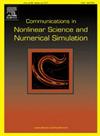Euler–Maruyama scheme for delay-type stochastic McKean–Vlasov equations driven by fractional Brownian motion
IF 3.4
2区 数学
Q1 MATHEMATICS, APPLIED
Communications in Nonlinear Science and Numerical Simulation
Pub Date : 2025-05-13
DOI:10.1016/j.cnsns.2025.108927
引用次数: 0
Abstract
This paper focuses on the Euler–Maruyama (EM) scheme for delay-type stochastic McKean–Vlasov equations (DSMVEs) driven by fractional Brownian motion with Hurst parameter . The existence and uniqueness of the solutions to such DSMVEs whose drift coefficients contain polynomial delay terms are proved by exploiting the Banach fixed point theorem. Then the propagation of chaos between interacting particle system and non-interacting system in sense is shown. We find that even if the delay term satisfies the polynomial growth condition, the unmodified classical EM scheme still can approximate the corresponding interacting particle system without the particle corruption. The convergence rates are revealed for . Finally, as an example that closely fits the original equation, a stochastic opinion dynamics model with both extrinsic memory and intrinsic memory is simulated to illustrate the plausibility of the theoretical result.
分数布朗运动驱动的延迟型随机McKean-Vlasov方程的Euler-Maruyama格式
研究了分数阶布朗运动驱动的延迟型随机McKean-Vlasov方程(DSMVEs)的Euler-Maruyama (EM)格式,该方程的Hurst参数H∈(0,1/2)∪(1/2,1)。利用Banach不动点定理,证明了这类漂移系数包含多项式延迟项的离散微分方程解的存在唯一性。然后给出了Lp意义下相互作用粒子系统与非相互作用粒子系统之间混沌的传播。我们发现,即使延迟项满足多项式生长条件,未经修正的经典EM格式仍然可以近似相应的相互作用粒子系统而不存在粒子损坏。给出了H∈(0,1/2)∪(1/2,1)的收敛率。最后,作为一个与原方程紧密拟合的例子,对一个同时具有外在记忆和内在记忆的随机意见动力学模型进行了仿真,以说明理论结果的合理性。
本文章由计算机程序翻译,如有差异,请以英文原文为准。
求助全文
约1分钟内获得全文
求助全文
来源期刊

Communications in Nonlinear Science and Numerical Simulation
MATHEMATICS, APPLIED-MATHEMATICS, INTERDISCIPLINARY APPLICATIONS
CiteScore
6.80
自引率
7.70%
发文量
378
审稿时长
78 days
期刊介绍:
The journal publishes original research findings on experimental observation, mathematical modeling, theoretical analysis and numerical simulation, for more accurate description, better prediction or novel application, of nonlinear phenomena in science and engineering. It offers a venue for researchers to make rapid exchange of ideas and techniques in nonlinear science and complexity.
The submission of manuscripts with cross-disciplinary approaches in nonlinear science and complexity is particularly encouraged.
Topics of interest:
Nonlinear differential or delay equations, Lie group analysis and asymptotic methods, Discontinuous systems, Fractals, Fractional calculus and dynamics, Nonlinear effects in quantum mechanics, Nonlinear stochastic processes, Experimental nonlinear science, Time-series and signal analysis, Computational methods and simulations in nonlinear science and engineering, Control of dynamical systems, Synchronization, Lyapunov analysis, High-dimensional chaos and turbulence, Chaos in Hamiltonian systems, Integrable systems and solitons, Collective behavior in many-body systems, Biological physics and networks, Nonlinear mechanical systems, Complex systems and complexity.
No length limitation for contributions is set, but only concisely written manuscripts are published. Brief papers are published on the basis of Rapid Communications. Discussions of previously published papers are welcome.
 求助内容:
求助内容: 应助结果提醒方式:
应助结果提醒方式:


